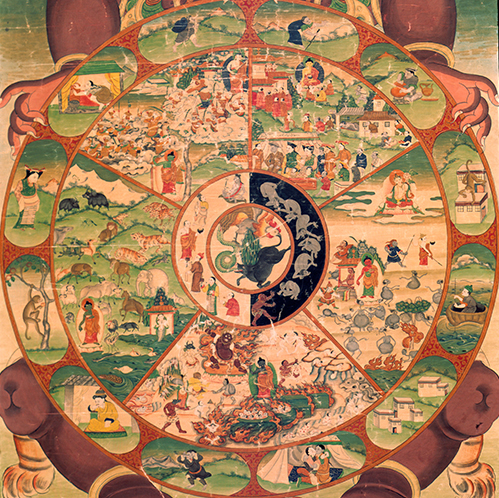
About the Meditation
This week’s meditation session is led by Swami Chidananda and the theme is: Liberation.
The guided meditation begins at 14:34.
For centuries Himalayan practitioners have used meditation to quiet the mind, open the heart, calm the nervous system, and increase focus. Now Western scientists, business leaders, and the secular world have embraced meditation as a vital tool for brain health.
Whether you’re a beginner, a dabbler, or a skilled meditator seeking the company of others, join expert teachers in a forty-five-minute weekly program designed to fit into your lunch break. Each session will be inspired by a different work of art from the Rubin Museum’s collection and will include an opening talk, a twenty-minute meditation session, and a closing discussion.
RELATED ARTWORK

This diagram summarizes the Buddha’s enlightening vision under the bodhi tree. It explains the cyclical process of life, death, and rebirth (samsara). The Lord of Death, Yama, grips a wheel driven by three animals representing the mental poisons—attachment (rooster), anger (snake), and ignorance (pig)—at its hub.
In the next circle from the center, people move upward to higher states of consciousness (light) and downward to afflicted states (dark). Their actions, polluted by the poisons, propel them in a continuous cycle of rebirth in the six realms of existence, depicted in the large segments around the two inner circles. These are the realms of gods and demi-gods (top left), humans (top right), animals (lower left), hungry ghosts (lower right), and hells (bottom). The wheel’s outer rim is the symbolic chain of causality that binds this closed circle with no clear way out.
When the Buddha comprehended its structure and dynamics of this cycle, he was also able to discern a pathway out of it that others can learn and follow. This is why the Buddha appears both outside the wheel, at the upper right, and within it, pointing the way out by teaching the Dharma.
About the Speaker

Swami Chidananda is a spiritual educator and monk initiated in the Vedic Hari Bhakta lineage, holding the distinguished title of Swami.
Through the study of scriptures such as the Bhagavad Gita and the Yoga Sutras of Patanjali, Swami has gained a deep understanding of the science of yoga and has devoted his life to helping others on their inner journey.
Before entering the spiritual path, he had a successful career as an investment banker and entrepreneur. Now, he uses his experiences to convey the ancient yoga systems in a relatable and accessible way for those seeking to reconcile Western and Eastern philosophies.
Additional information about Swami can be found by exploring his Instagram page @swami_chidananda, or by listening to his podcast, The Path of a Swami.
This program is presented in partnership with Sharon Salzberg and teachers from the New York Insight Meditation Center, the Interdependence Project, and Parabola Magazine and supported by the Frederick P. Lenz Foundation for American Buddhism.

